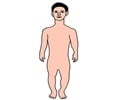Q: Which doctor can I consult if my baby is diagnosed with achondroplasia?
A: You will have to consult a pediatrician, orthopedic surgeon, dental surgeon and a neurosurgeon depending on the complication that requires treatment.
Q: What can be done for patients with achondroplasia?
A: Children and adults with achondroplasia can lead normal lives provided they receive attentive, informed care by their physicians and parents.
Q: Is being a dwarf considered a disability?
A: People with achondroplasia can live a normal life although they might have other complications they have to deal with in life. They are intellectually on par with others. However, they do get disability benefits in America.
Q: How many different types of dwarfism are there?
A: There are several types of dwarfism which are classified into two main types – proportionate dwarfism where the person is short but the body parts are proportionate, and disproportionate dwarfism which includes achondroplasia.
Q: What does double dominance mean?
A: A person having achondroplasia has one dwarfism gene and one average-size gene. When two parents with achondroplasia have a baby, there is a 50% chance that the child will have one dwarf and one average-size gene and have achondroplasia, just like either parent. There is a 25% chance that the child will inherit the average-size gene from both the parents and be of normal height. The 4th scenario when the child inherits the dwarf genes from both parents (25% chance) is known as double dominance and is lethal.
Q: Are there other syndromes that affect the same gene as achondroplasia?
A: Yes, thanatophoric dysplasia (TD) and hypochondroplasia also occur due to defects in the FGFR3 gene.
Hypochondroplasia is classified as short-limbed dwarfism and has clinical features similar to achondroplasia but are milder.
Thanatophoric dysplasia is a severe skeletal disorder resulting in stillborn children or death shortly after birth from respiratory failure.









